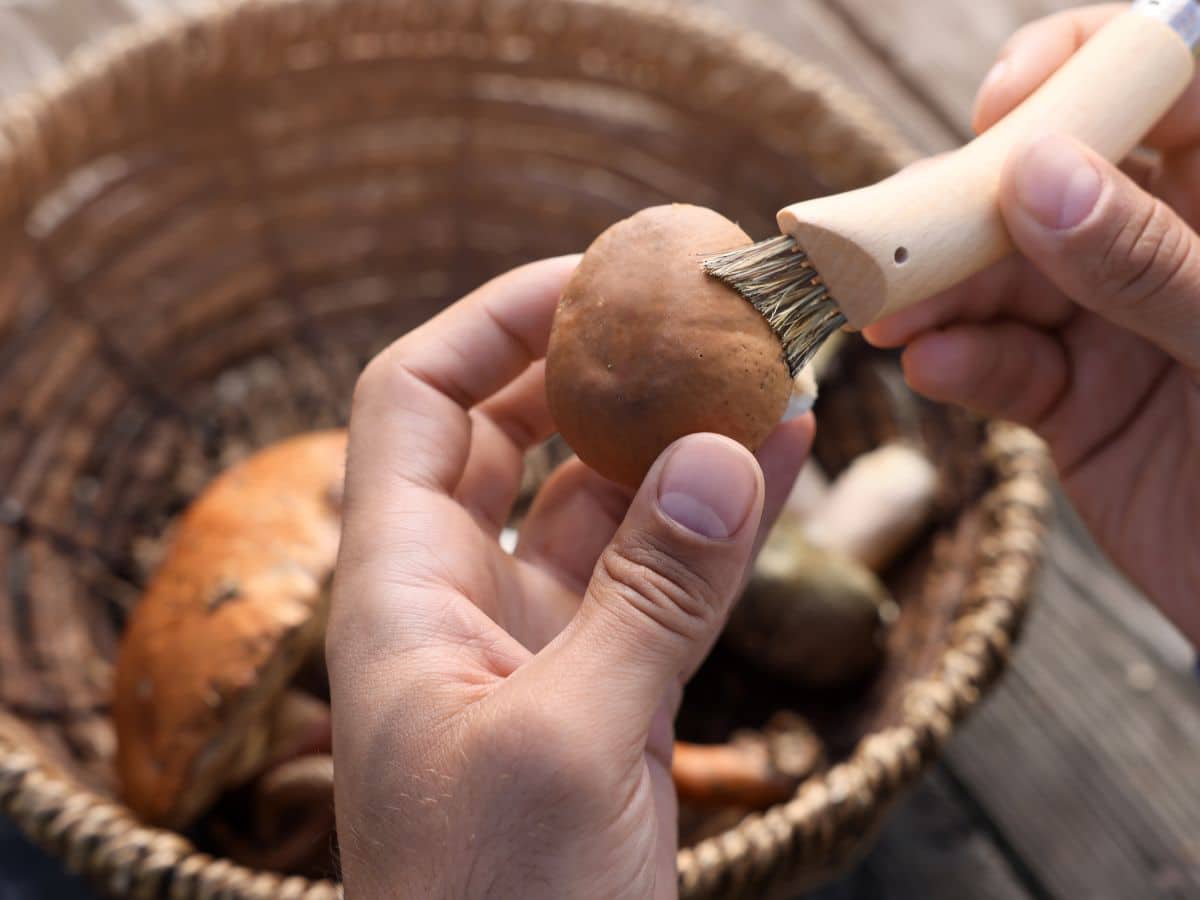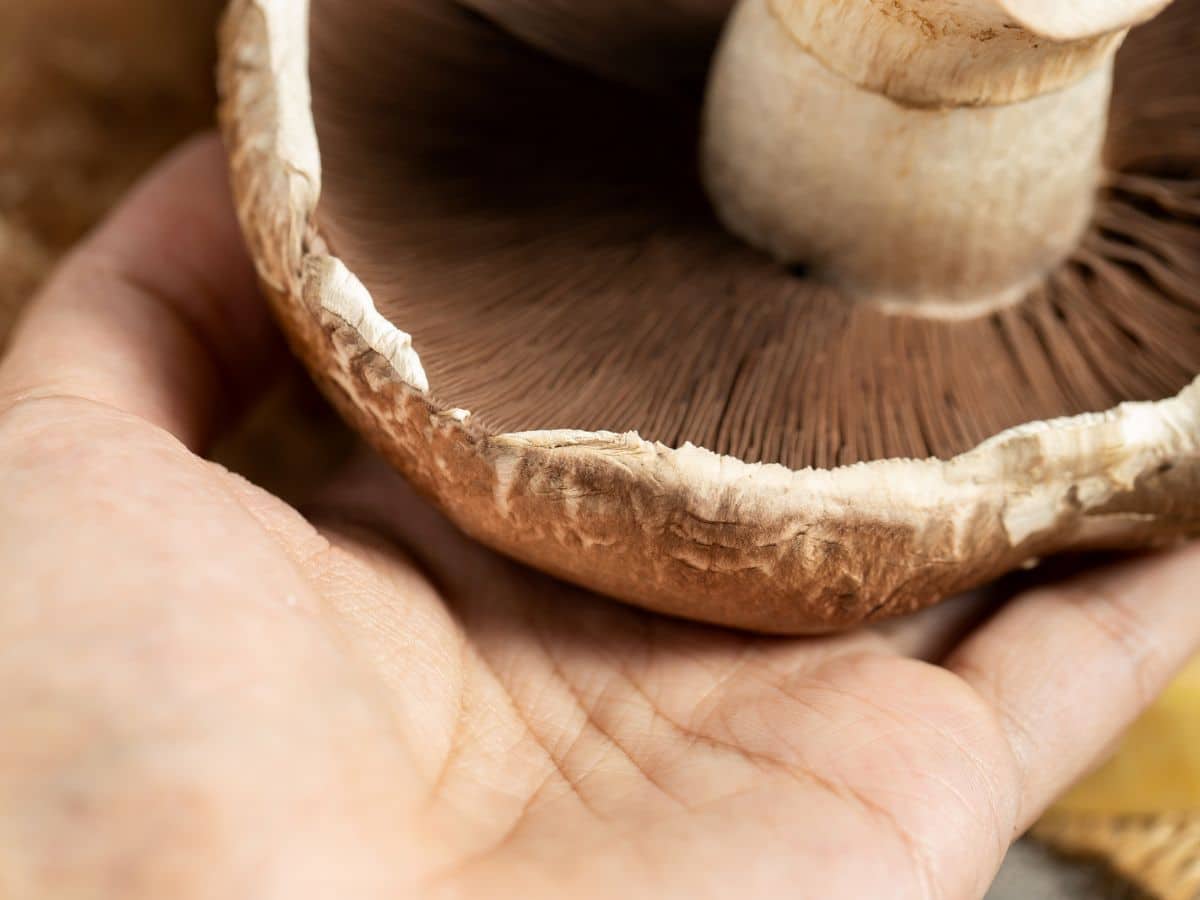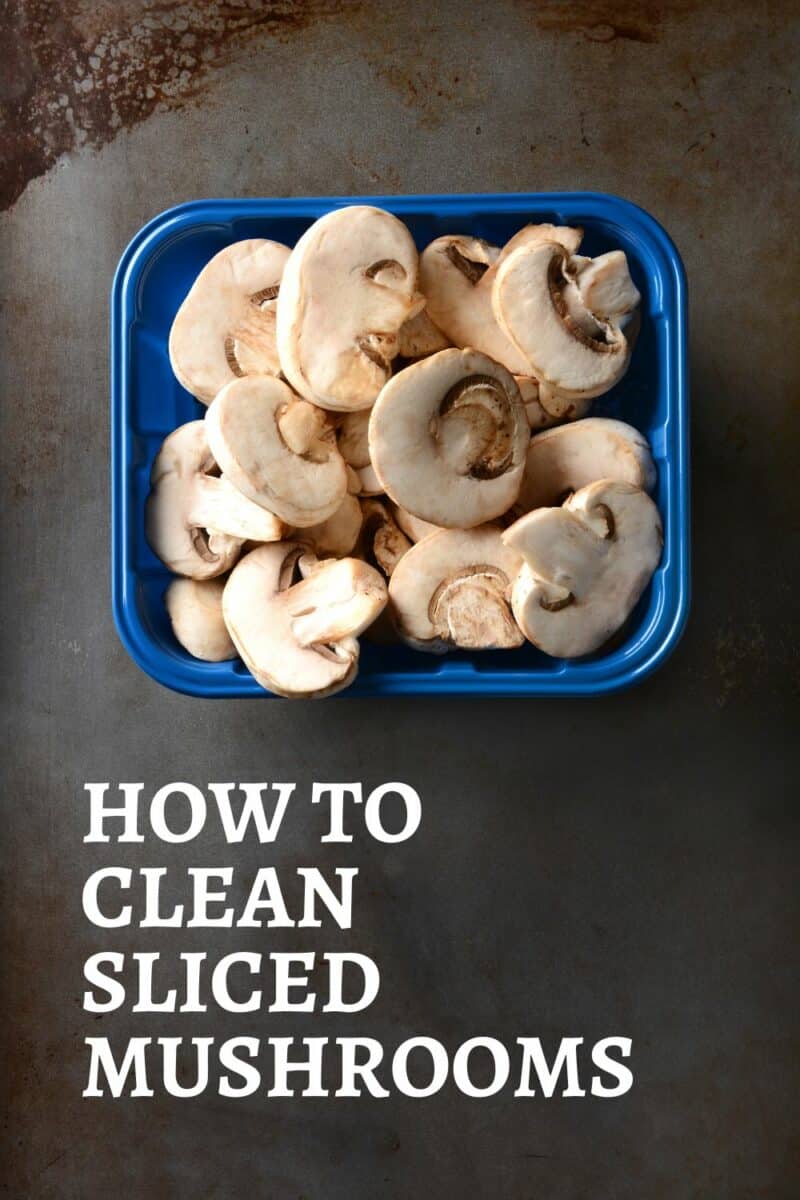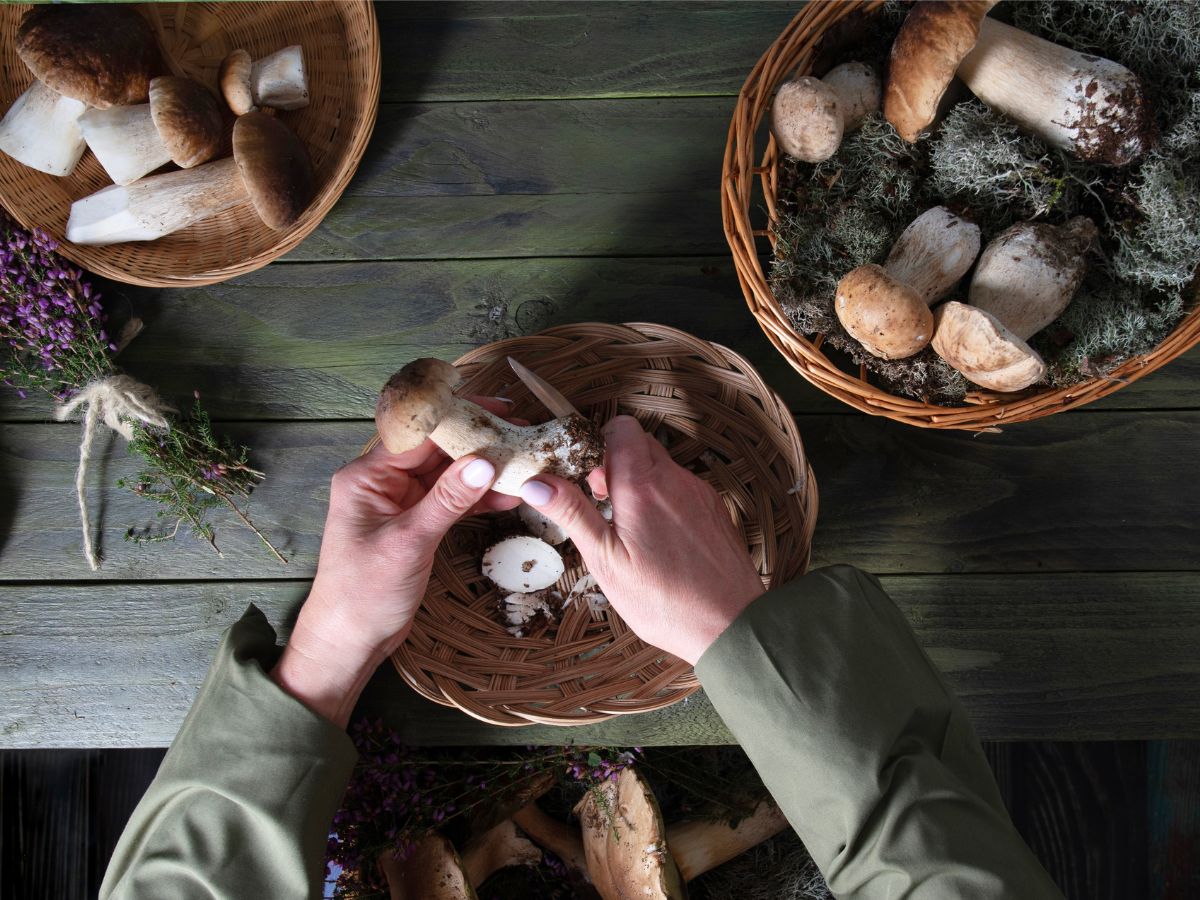
Have you ever stared down a container of fresh mushrooms and wondered how to properly clean them? This guide details how to clean mushrooms correctly — ensuring they’re not just clean but at their best for however you plan to enjoy them.
The information provided on this site is based on my personal experience living with alpha-gal syndrome. I consistently cite and link to expert sources, but nothing published on this site should be perceived as medical advice.
Alpha-gal sensitivities vary by person. You should understand your dietary restrictions, making any adjustments needed, and directing any questions to your physician.
Cleaning mushrooms might seem like a simple task, but it’s one that’s often misunderstood. From old wives’ tales to conflicting advice from culinary experts, it’s easy to get lost in the ‘shroom shuffle. This guide digs into and debunks the myths, delivering tried-and-true methods to leave your mushrooms in peak condition, whether you’re sautéing, stuffing, or frying them.
To help offset the costs of running SageAlphaGal.com, you’ll find affiliate links lightly sprinkled throughout the site. If you choose to make a purchase via one of these links, there’s no additional cost to you, but I’ll earn a teeny tiny commission. You can read all of the legal blah blah blah (as my little niece says) on the full disclosure page.
In This Article

Why are Mushrooms Always Covered in Dirt?
The earthy, umami flavor of mushrooms is a delicious part of many savory dishes, from comforting casseroles to creamy vegan risotto. But you’ll need to clean these fabulous fungi of any excess dirt and debris before using them in your cooking.
Have you ever purchased white button or cremini mushrooms and discovered a pile of dirt at the bottom of the plastic container and several specks of dirt coating each mushroom? Yeah, me too.
Here’s the dirt on why they’re so, well, dirty! These mass-produced mushrooms are grown in a peat mixture. While it’s sterilized and safe to eat, you still want to clean off as much as possible before cooking.
Want Alpha-Gal Safe Recipes and More?
Sign up for the weekly newsletter!
Thank You for Subscribing!
How to Clean Mushrooms
When cleaning mushrooms, you’ve got two camps: Team Dry and Team Wet. The dry method involves brushing debris off with a damp cloth, and the wet method includes rinsing and washing the mushrooms. Whichever way you choose, clean the mushrooms just before cooking them. Otherwise, you’re likely to end up with soggy, slimy mushrooms. Ew!

Dry Cleaning Method
The dry method of cleaning mushrooms involves using a damp paper towel, a clean kitchen towel, a dry paper towel, or a mushroom brush. Yes, such a tool exists, and it’s one of the few single-purpose kitchen gadgets worth owning.
The dry cleaning method is a bit tedious, but there’s a good reason for it. Mushrooms are incredibly porous. If soaked with water during cleaning, they become mushy and soggy and will never brown nicely in a recipe.
To clean mushrooms using the dry method, gently brush the dirt and debris off each one using a slightly damp towel. This method works well for any mushroom with a defined cap, such as white button, cremini, portobello, chanterelle and shiitake.
“I always clean my mushrooms with a mushroom brush rather than a towel. A mushroom brush is more effective because its soft bristles gently remove dirt and residual soil without damaging the mushroom’s delicate surface.”
— Sara Nelson, Real Balanced

Wet Cleaning Method
If you’re short on time or dealing with pre-sliced mushrooms, the wet method is your friend. Despite what your mom, grandmother, and every other seasoned cook has probably told you about not washing mushrooms, you can lightly rinse them under water. The key word, however, is lightly. Think of this method more like a quick shower than a long soak.
There are two approaches to the wet wash method:
- Strainer Method — put the mushrooms in a strainer or colander and lightly rinse them with cool water
- Bowl Method — add the mushrooms to a large bowl of water and gently toss them in the water for 30 to 60 seconds until the debris falls off
Whichever method you choose, pat those mushrooms dry afterward to soak up any lingering moisture. The goal is a quick rinse, not a soak.

Preparing Mushroom Caps for Stuffing
Whether using white button or portobello mushrooms, if you plan on stuffing mushroom caps, you’ll need to take a few additional steps to prepare them. Once you have cleaned the mushrooms using one of the methods above, remove the mushroom stem. It will typically snap off with a gentle tug, but if needed, use a small sharp knife to remove the stem where it meets the cap.
If you’re stuffing one of the larger varieties of mushrooms — like a portobello — the next step is to remove the gills. To do this, hold the mushroom in your hand with the gills facing up. Then, use a spoon to gently scrape off the gills and make additional space for the delicious stuffing.
Related Article: Spinach Stuffed Portobellos Recipe

What to do With Mushroom Stems
Many people discard the mushroom stems as part of the cleaning and prepping process. Tossing the stems is a huge oversight, because mushroom stems can be used in several ways.
When making stuffed mushrooms, mushroom stems can be diced and added to the stuffing for a richer flavor. You can also dice them and add them to mirepoix at the start of dishes like ragus, soups, and stews. And if nothing else, mushroom stems make a great flavoring component to any homemade stock or broth.
You can use portobello stems as an alpha-gal friendly substitute for bacon bits on everything from salad to loaded baked potatoes. Finely dice them, season them with salt and pepper, and then cook them in hot oil until they are crisp and brown.

Unique Mushroom Varieties
Mushrooms are having a moment lately with the rise of adaptogenic powders and people’s newfound understanding of their potential health benefits. Because of this, varieties like lion’s mane, turkey tail, trumpet, maitake, and reishi are making their way into markets.
These mushrooms are a far cry from the standard button mushroom in appearance, and cleaning them can be confusing.
The good news is they seldom hold as much dirt and debris as conventional white mushrooms or portobello mushrooms since they’re grown differently, so they may not need much cleaning.
However, If you spot some dirt on these mushrooms, it’s best to use the dry method. A soft pastry brush can also make a good cleaning tool for mushrooms such as lion’s mane or maitake (also called hen of the woods).

Morel Mushrooms
Morels have a specific cleaning approach due to their unique composition. If you’re lucky enough to get your hands on this wild mushroom, knowing how to clean them correctly is essential.
Morel mushrooms have a hollow center and a sponge-like top that allow dirt, bugs, and other insects to hide. Since morels are foraged in the wild and not grown commercially, they’re often full of this kind of debris.
To properly clean these mushrooms, slice them in half vertically and soak them in water. Change the water as needed until all the visible dirt and debris are gone. Rinse them well, then pat dry before cooking. Morels have a nutty, earthy flavor and meaty texture, making them delicious as a pizza topping.
The Final Word on Fungi
Whether you’re pickling them for an alpha-gal friendly charcuterie board or air frying mushrooms for a quick and easy umami-flavored side dish, knowing the proper method for cleaning mushrooms is an essential step in the cooking process. It may seem simplistic, but an improperly cleaned mushroom can significantly impact the final dish’s flavor and texture. Their nutty, earthy, and savory taste is at its peak when the mushrooms are kept as fresh and dry as possible.
How Do You Clean Mushrooms?
Now that you’re a mushroom-cleaning pro, I want to hear from you! What new tip or trick did you learn about these cleaning methods? Got any mushroom cleaning hacks of your own? Share your thoughts in the comments below!
Portions of this article originally appeared on Food Drink Life.



Thank you for sharing!

